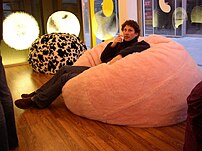Removing Pews to Add Members
I just read an interesting article about a Catholic church in Westchester, New York, that removed pews as a way to add members. Sounds ironic, doesn't it?
We're used to thinking of churches from their external architecture. But the attempt to re-arrange furniture in sanctuaries to make them more home-y, more come-fy, more welcoming is a type of innovation that has led to the radical re-design of worship sanctuaries across America. If you haven't seen it, it seems strange. But for the thousands who have, it's a non-issue.
Re-thinking the Chairs
 A couple of years before Mosaic in Los Angeles became "Mosaic," I was in the main auditorium of the old East L.A. building when "Art," the facilities supervisor, was setting up chairs. These were individual, wooden chairs with blue-ish cloth for cushion that were set up every week in a multipurpose space called "the sanctuary."
A couple of years before Mosaic in Los Angeles became "Mosaic," I was in the main auditorium of the old East L.A. building when "Art," the facilities supervisor, was setting up chairs. These were individual, wooden chairs with blue-ish cloth for cushion that were set up every week in a multipurpose space called "the sanctuary."Art carried a stick, placing it over various chairs and appearing to measure the space between each one as he arranged each seat. I asked, “What’s the stick for, Art?” He stopped and explained that “The Stick” was a tool he invented. Originally a PVC pipe, the stick was now the end of a broom exactly 40” long used to ensure chairs were placed at exactly the right distance from each other.
Art had mapped out carefully the geometry of the auditorium, and the placement of chairs was a precise operation. Art’s use of the stick seemed to be a logical solution for placing individual chairs together neatly. After all, the goal of arranging chairs is simple. They “should” be placed one next to the other in straight rows facing the platform with a wide space in the middle for a center aisle.
 With Art’s stick, chairs were laid out with precision and care. Each chair had its proper place within an efficient arrangement for congregational entry, seating, and exit. The arrangement was standardized and even. When finished, the chairs looked like squarely arranged “pews” much like the Roman Catholic Church I had visited as a child. The sanctuary was ready for worship.
With Art’s stick, chairs were laid out with precision and care. Each chair had its proper place within an efficient arrangement for congregational entry, seating, and exit. The arrangement was standardized and even. When finished, the chairs looked like squarely arranged “pews” much like the Roman Catholic Church I had visited as a child. The sanctuary was ready for worship.But this simple and seemingly obvious arrangement of chairs changed when Erwin McManus became lead pastor. For him, the chairs were separate and individual. That meant they could be arranged and re-arranged in various ways, didn’t it?
Straight "Pews" to Messy "Seats"
The journey of chair arrangement began. Chair rows began to be “curved” rather than “straight.” A moveable stage was created and placed in different spots in the auditorium, re-orienting the platform and, therefore, the direction toward which seats were faced. The “front” of the auditorium became irrelevant since the “front” changed week to week. At one point, the stage was in the center, and chairs were placed all around it; at another point, congregants were asked to re-arrange their chairs during the message into circles around each other.
At several moments throughout the years I saw Art arranging seats with his stick, and chairs found their way back to being “straight” and “squared.” But not for long. After a few weeks, a new round of movement and experimentation commenced. Then came a paradigm shift.
 A comfortable living room. Image not from Mosaic but via Wikipedia
A comfortable living room. Image not from Mosaic but via Wikipedia
With the launch of a new Sunday night service, a couple of volunteer leaders had an idea. They looked over the auditorium and re-planned the space.
Chairs were suddenly and almost completely replaced with couches, bean bags, futons, love seats, and lounge chairs. Coffee tables and end tables were brought in with free-standing lamps and lots of candles. Plants, rugs, and vases were placed everywhere. A maze of cozy spots for sitting, talking, and listening was fashioned to feel more like a home than a church sanctuary. Several respondents echoed one member's reaction to this setting on their first visit to Mosaic:
 Bean bag chairs used in a church? Image not from Mosaic but via Wikipedia
Bean bag chairs used in a church? Image not from Mosaic but via Wikipedia
"It was like stepping into a living room. It wasn’t like stepping into a cold building; it was like stepping into someone’s living room with the couches and the way it was setup. It had that comforting feeling. It was such a warm feeling to step into."
From that point on, straight rows were gone. Art’s “stick” became irrelevant.
Ask about the Seating -- Every Space is a Social Space
When we visit churches as one-time guests, we miss out on the changes and negotiations that arrange a sanctuary space. The thing to remember is that every sacred space is a social space, cultivated by people who arrange "spaces" to make them "places" that fit a group's understanding of what is "appropriate" for worship.
This “history” of seating at one church shows how the arrangement of chairs can be a consistent and noticeable site toward innovation within the congregation. Of course the arrangement of space is often contentious -- the arrangement of sacred space is rife with the potential for conflict. More than a few churches have had knock-down, drag-out fights about the color of the carpet, the placement of the pulpit, the speakers on the ceiling, etc.
Yet, the decisive leap of creativity in the history of Mosaic in transforming the “church sanctuary” to a “living room” came as a result of the work of an innovative lay leader in the congregation who viewed the change as an important contribution to the goals of the church. It should be a welcoming place. It should be more like a living room than a "sanctuary."
Some churches have taken this much further. There's even churches who name themselves The Living Room here and here and here.
Adding, removing, or shifting the seating arrangement can be one of the most subtle aspects of a congregation's ministry. So, whenever I visit a congregation, I always remember to ask about the seating.When you try this, I think you'll be surprised how often you will be treated to a pretty good story.



1 comment:
I sent this to some of the leaders in our church. My message title was "How to make the elderly angry"
Post a Comment